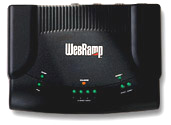The Hub
Before I get too far ahead of myself
let's take a look at the rear of the unit. On the rear of the unit are three
serial connectors for the modems or ISDN connections. Adjacent to these is
a female serial connector labeled "console". Adjacent to these are the four
ports for the built in hub. Lastly is the connector for the power cord. Notice
that there is no WAN connector to allow the unit to later serve as a hub for
DSL or Cable service. The unit is shipped with one ethernet cable and two
CD's. One CD contains the software to make the unit work and the other CD
is the CacheLink software. CacheLink allows you to pool the internet cache
of your different computers together so that when users at different computers
view the same page they can pull the files necessary to display a page off
each other's computers rather than waiting for the data to be downloaded from
the internet. I'll discuss the effectiveness of CacheLink later in the review.
 The
350e comes equipped with a 10BaseT 4 port hub. This may prove to be the Achilles'
heel of the unit. 100 MBps networking equipment has been available for some
time, and most users would be better off with 100 MBps of bandwidth compared
with the 10 MBps that the 350e features. While this hub has the ability to
have 253 users routed through it once more hubs are added behind it, I find
it hard to believe that the unit will not be seriously congested with only
ten users. Once several users begin to use the internet the unit will have
heavy demands put on it. Add in the browsing into each computer's cache necessary
to make CacheLink work and I think you'll see that there will be data moving
from different computers looking for the computer that requested the data,
and the added traffic that loading pages from the internet will inflict on
the network. This is simply not a great idea, especially with only 10 MBps
of total bandwidth for the network. Why will CacheLink make the congestion
worse and not better?
The
350e comes equipped with a 10BaseT 4 port hub. This may prove to be the Achilles'
heel of the unit. 100 MBps networking equipment has been available for some
time, and most users would be better off with 100 MBps of bandwidth compared
with the 10 MBps that the 350e features. While this hub has the ability to
have 253 users routed through it once more hubs are added behind it, I find
it hard to believe that the unit will not be seriously congested with only
ten users. Once several users begin to use the internet the unit will have
heavy demands put on it. Add in the browsing into each computer's cache necessary
to make CacheLink work and I think you'll see that there will be data moving
from different computers looking for the computer that requested the data,
and the added traffic that loading pages from the internet will inflict on
the network. This is simply not a great idea, especially with only 10 MBps
of total bandwidth for the network. Why will CacheLink make the congestion
worse and not better?
With only a few users I can see
that CacheLink will be a timesaver. Moving data on a 10 MBps network from
one computer to another is much faster than downloading that same data from
the internet. Waiting for the data to download introduces the lag that is
inherent with modems. A problem arises because this hub does not feature a
switch. This was a criticism of mine with the other hub sent by Ramp Networks.
A switch can be likened to a traffic light. It will allow the data to move
from one computer to another smoothly and it will direct the data exactly
to the computer that needs it. Without a switch the data must move from computer
to computer on the network until the computer that requested the data is found.
I can't tell you enough what a huge improvement in speed and reliability can
be obtained by using a switch. Now imagine 20 or 30 computers hooked up behind
this hub and the congestion with data moving from computer to computer looking
for the right machine to deliver the data to. For a small network - usually
five or fewer machines - a conventional hub like the one in the 350e may serve
the needs of the business just fine. I'd highly recommend users who plan to
expand their network beyond that size look into a switch and 100 MBps speed.
For a network that is that small I think CacheLink is a great idea. I think
CacheLink would be best used on a switched network running at 100 MBps since
it would allow the highest possible access to that data without the congestion
associated with normal hubs.
